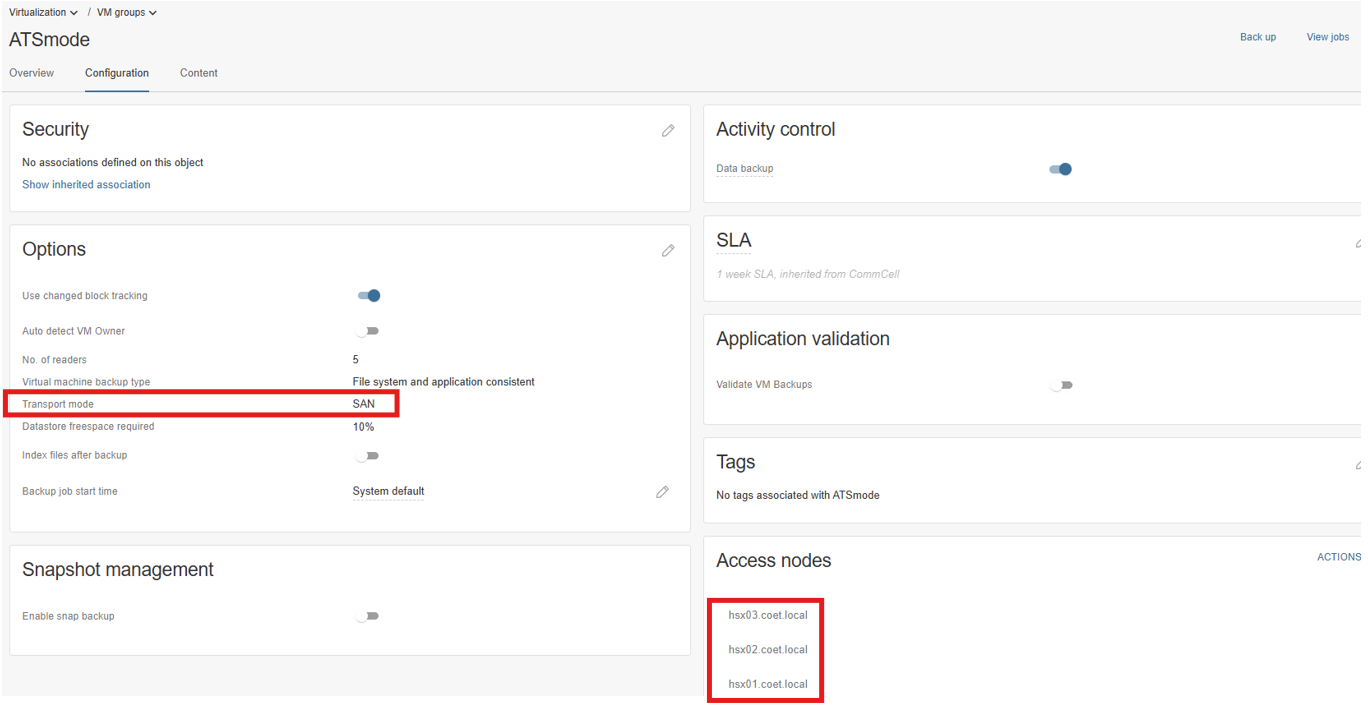Introduction
Hitachi Data Protection Suite (HDPS) integrated with HyperScale X delivers blazing-fast VMware backups through SAN transport mode while streamlining operations by eliminating ESXi host bottlenecks and LAN overhead. At the core of this solution is Hitachi’s Global-Active Device (GAD) technology for enterprise-grade resiliency. HyperScale X using SAN Transport Mode.
takeaways:
Takeaway 1:
For optimal performance and to avoid intermittent errors, VMs should exclusively use Atomic Test & Set (ATS) for datastores. The older ATS+SCSI locking method is prone to issues because it locks entire volumes, leading to errors. In contrast, ATS only locks specific storage blocks, ensuring safe and efficient shared storage access. Notably, HDPS backup and restore operations perform optimally with VMs using ATS-only datastores.
Takeaway 2:
recommended to add all HyperScale X nodes as individual access nodes in HDPS and subsequently use HDPS to bind the VM groups to SAN Transport Mode. This helps distribute the backup workload across the entire HyperScale X cluster and allows HDPS to run multiple concurrent backup streams in parallel.
Takeaway 3:
Using a single, consistent datastore mode across an ESXi cluster is crucial for stable backup operations. Configure all ESXi datastores uniformly and avoid mixing 'ATS' with 'ATS + SCSI'. To remediate a mixed environment, for all backing LUNs to ATS mode. Following this, the datastores must be removed and re-added in vSphere to enforce the change.
Takeaway 4:
For smooth backup and restore operations, ensure VMware, underlying hardware, HDPS, Hyperscale X, and Hitachi Block storage all have the latest software and firmware patches.
Test details:
Figure 1 describes the environment used for the evaluation.
Table 1 Details of Components Used in Evaluation:
Storage provisioning and host setup:
Provision storage: Configure global-active device pairs between two VSP E590 storage systems in a single-server environment using Asymmetric Logical Unit Access (ALUA) for high availability across metro distances (typically up to 300km). Two 4TB LUNs were provisioned as GAD P-VOLs on the VSP E590 storage system.
VMware ESXi cluster setup: Two hosts were clustered for fault tolerance, with VCSA configured to manage them at the cluster level.
etup:
HyperScale X deployment: A three-node Commvault HyperScale X appliance was deployed as the backup target. The HyperScale X architecture natively integrates MediaAgent and VSA Proxy packages, which operate as backup access nodes (data movers) and destination repositories. https://documentation.commvault.com/2023e/essential/commvault_hyperscale_x.html
For SAN transport mode, HyperScale X backup nodes need Fibre Channel (FC) access to source datastore LUNs. The subsequent section, SAN transport mode configuration, provides step-by-step details.
SAN transport mode configuration:
It is the fastest and most efficient way to back up VMware virtual machines (VMs) with Commvault, especially when using HyperScale X. Instead of moving data over the production network, HDPS's VSA proxy directly accesses VM data from SAN storage.
To enable SAN transport mode, fibre channel (FC) access to the source datastore LUNs is required for both the ESXi hosts and HyperScale X backup nodes.
The following steps were implemented:
-
source datastore LUNs were mapped to all HyperScale X nodes and ESXi hosts, with multipathing configured for failover redundancy.
-
HyperScale X nodes automatically recognize LUNs as raw block devices, enabling SAN-optimized backup/recovery with no manual intervention.
-
In the VCSA, ATS-mode datastores host the application that is being protected across different VMs.
-
Deployed and configured CommServe on the designated server to orchestrate backup workflows, ensuring seamless integration with SAN transport mode.
-
Configured an HDPS Storage Pool using three HyperScale X nodes and defined a Backup Plan for policy-driven data protection. Creating a HyperScale X Storage Pool
-
Added vCenter to HDPS for enabling centralized management of VMware VM backups.Configuring Backups for VMware VMs
-
Created dedicated VM groups in HDPS and associated them with the Backup Plan to ensure consistent, role-based protection. Creating a VM Group for VMware
-
Modified VM group configurations to include HyperScale X nodes as access nodes and set the transport mode type to SAN.
Backup Source
HDPS
Backup Target
Conclusion:
This solution showcases the seamless integration of HDPS with Commvault HyperScale X, utilizing SAN transport mode to enhance VMware backup and recovery operations. To fully capitalize on its advantages, it is crucial to adhere to best practices related to SAN transport mode configuration, VMware ATS mode, and firmware compatibility. By eliminating traditional LAN-based bottlenecks and overcoming ESXi host constraints, the test cases validate that organizations aiming to modernize their VMware data protection strategies can confidently adopt this solution to achieve greater resilience and operational efficiency.
Reference:
https://kb.commvault.com/article/87680 -- Commvault support article.